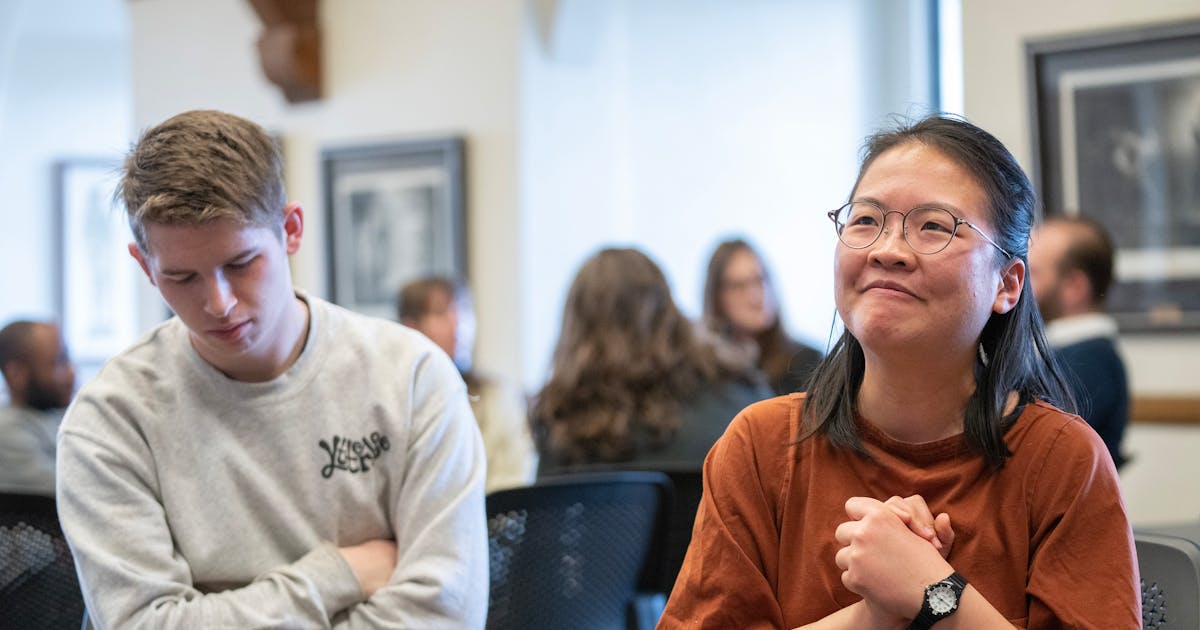Star Tribune
At St. Olaf College, talking about death is on this ‘cafe’ menu

NORTHFIELD – Gloriana Ye wonders why her parents no longer wanted her to help clean her ancestors’ tombs back in Taiwan.
Sitting in a small circle inside a stately classroom at St. Olaf College, Ye told a handful of other people how growing up, her family followed an April tradition where they’d visit cemeteries bearing gifts to honor dead relatives and cleaning supplies to tidy their resting places. She doesn’t go along anymore, though: As she got older, her parents kept telling her they’d take care of it instead.
“I wish I can go,” she said. “I wish I can learn more about my ancestors’ legacy and be there to send my respect.”
Talking about death and dying isn’t easy, but St. Olaf students and faculty have tried to make it easier in recent months. Ye and other organizers have put on so-called “death cafes” in an effort to help people deal with a topic that’s too often off-limits.
“It follows people,” St. Olaf senior Grace Tillman said. “People bring that trauma with them all the time.”
The concept started in 2004, when Swiss sociologist Bernard Crettaz decided to host a “café mortel” to create public discussions on the subject. His own wife died in 1999. The gatherings grew as more people adapted Crettaz’s ideas; Jon Underwood brought death cafes to the United Kingdom in 2011 and created a website to spread the model.
A death cafe follows four general guidelines: They’re always not-for-profit. They’re held in a comfortable, confidential space. Organizers never lead participants to any sort of conclusion or action; the discussions flow on their own. And they always involve treats, preferably cake.
Ye brought the idea to St. Olaf, Northfield’s resident Lutheran college of more than 3,000 undergraduate students on a bluff overlooking the Cannon River. A senior seeking her nursing degree, she worked at a nursing home where she heard many of the residents discuss dying and was struck by how little her college peers talked about death.
“It seems like there’s a taboo when people talk about the questions of how and why lives end,” she said.
The cafes have been a hit since Ye proposed the idea last fall. The university’s Lutheran Center for Faith, Values and Community embraced it, providing space and funding for five cafes thus far. One was held just for medical students studying cadavers, while the others were open to the public.
The last one this year is scheduled for May 1.
“This space invites people to bring their whole selves, which includes their religious identity, their spiritual sensibilities, but it’s not an explicitly religious space,” said Deanna Thompson, director of the Lutheran Center. “Those spaces are where students can feel like they can explore these questions and figure out what it is they believe.”
Ye and other interfaith fellows at the center run the meetings, asking open-ended questions for more than an hour on how people define death and what topics they’d like to discuss.
At Wednesday’s meeting, a group of nine adults talked about the finite, inevitable end death brings to us all. They discussed what it feels like to watch a loved one die, what a good death means to them, what people should do to prepare for their deaths.
One person described how her grandfather’s sudden death changed how her family planned for their future, and how her parents entrusted her with their burial plans. Another told a group how a grandmother drifted in and out of hospice care for a decade before dying at 104 — and what a relief it was for family members who no longer wanted her to suffer.
Yet another talked about how her son’s church organized singing groups for people on their deathbeds, sending them off with song. And one person even pondered how she was going to follow her dad’s burial plan to have a Viking-style funeral by setting fire to his body on a boat, which is illegal in Minnesota.
“People our age, we feel like we’re invincible,” said Caroline Anderson, another cafe organizer and senior majoring in psychology. “But death enters into your life at any time. You can’t prepare for it.”
College officials say they plan to continue the discussions next year, long after Ye graduates to take a nursing job at a cardiovascular ward in a Chicago hospital. They hope the lessons students take from these talks help them as they navigate their careers, their adulthood, and the rest of their lives.
“I definitely think we need a different way to talk about this in our culture,” Ye said. “We’re trying to reduce the friction so people aren’t afraid to initiate these conversations.”
Star Tribune
Worthington woman dies in crash on Interstate 90
A Worthington, Minn., woman was killed Friday when her vehicle was rear-ended on Interstate 90 outside Worthington.
According to the State Patrol, 75-year-old Christie Lee Eichner was killed shortly after 1 p.m. when a pickup truck hit her SUV while she was stopped in a lane on I-90. The accident at 1:12 p.m. Friday.
The pickup driver was a 45-year-old woman from Redfield. S.D., who had her two teens in the vehicle. None of them were injured in the crash.
Eichner was taken to Worthington Hospital, where she died of her injuries. Authorities said she was not wearing her seatbelt during the crash. Alcohol was not believed to be a factor in the crash.
Star Tribune
Building on popular high school classes, St. Paul school district launches two Karen kindergartens

And right away, parents started asking for elementary programs as well.
“The immediate follow-up question from the community, once we started the high school courses, is, ‘Well, when can they start sooner?’” said Megan Budke, the district’s immersion, Indigenous and world language coordinator. Students have better academic outcomes when they are able to study languages throughout their K-12 career, she said.
Karen is the fifth-most common home language of Minnesota students, after English, Spanish, Somali and Hmong, according to state data. About half the state’s 5,000 Karen students attend St. Paul Public Schools. But in recent years, Karen enrollment in the district has seen a slight decline, while the share of Karen students attending metro charter schools has been on the rise.
Jackie Turner, the St. Paul district’s executive administration and operations chief, said that while an increasing number of Karen students are leaving the district, they are not finding Karen language, cultural programs or staff in other schools.
“There was a market that wasn’t being served,” she said.
Turner sees the expansion of Karen offerings as an opportunity to lure families back to the district. Wellstone Elementary has enrolled 57 new students as a result of the Karen kindergarten, including 30 kindergartners and 27 older siblings. About 80% of the older students were not enrolled in St. Paul Public Schools last year, Turner said.
Star Tribune
New painting depicts Cottage Grove city history
The city of Cottage Grove has a new painting at Cottage Grove Middle School that depicts the city’s history.
Commissioned from artist Eric Dowdle, the $75,000 project was paid for with funds from the Cottage Grove Economic Development Authority trust. Dowdle, a Utah artist, used places and people significant to the city’s development as his subjects, from Tank’s Corner Stand to the Zywiec’s Corn Maze and others.
Dowdle typically makes puzzles of his paintings, and his company Dowdle Folk Art has sold some 30 million puzzles based on 400 pieces of his artwork, according to his company. He’s the subject of a series on Amazon Prime Video “Painting the Town with Eric Dowdle.” The series is now called “The Piece Maker” and is available on Discovery+ and HBO Max.
A puzzle of Dowdle’s Cottage Grove painting will be available for sale at City Hall starting Monday, with proceeds going back to the Economic Development Authority. The puzzles will cost $28 for a 500-piece version, and $30 for a 1,000-piece version. The painting was commissioned in December of last year and approved by both the City Council and the Economic Development Authority.



